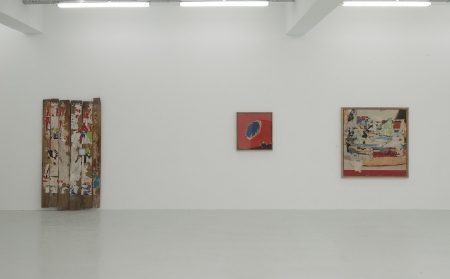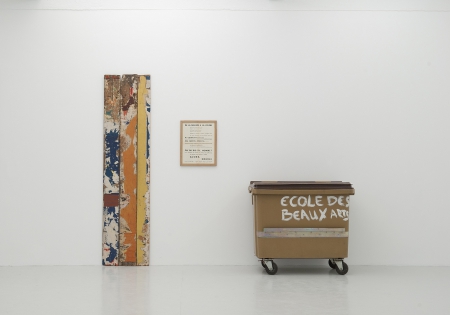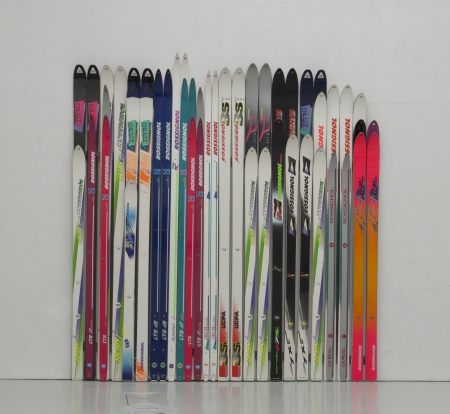Why the Palissades. A collector's view.
Raymond Hains is an affichiste, an artist who works with posters who was associated for a while with the Nouveaux Réalistes, but he soon shrugged off such labels. In this respect, the work he did with construction site boarding, the Palissades, is exemplary. It comes from a moment (1959) when Hains was moving way from the pattern he had set with his torn posters and photographs. He now developed a strategy in which his works were animated by a discourse based on puns and semantic shifts. Writing in Formes de vie, Nicolas Bourriaud says that a palissade is a “verbal matrix, a turbine for ‘portmanteau words’.” These portmanteau words are informed by a number of recurrent themes, such as the punning evocation of Monsieur de la Palice (whose name was associated with truisms, or lapalissades, such as “If he weren’t dead, he would still be alive”), the notion of the work in progress. This word play functions in the manner of moral tales or fables, serving to reveal situations that are indicative of the status of the artwork and the condition of the artist. In this respect he is close to Marcel Broodthaers and his allegories with the euphony of verbal rapprochements (Aigle/Aigre [Eagle/Bitter] Château des Aigles/ Musée des Aigles: the eagle signifies the seizure of power by certain artists or institutions. The contrast would be the mould: cunning and adaptability (Mould-Mussel/Muse/Medusa-Jellyfish). For both artists, it’s a matter of existing in the margins, out of the tides and headwinds of fashion, of developing a strategy for avoiding and mocking the art system and reappropriating their proper place.
The two sets of work follow each other, both unaggressive or overwhelming but visually different, or even incompatible, with the second linked to the first by a secret passage. To find it, we need to refer to the artist. How does the artist elicit the existence of this “off-screen” commentary? Two methods for the same strategy. A corollary.
1.
The insufficient work. François Dufrêne very appositely wrote that “Hains’ genius consists in being interested in uninteresting things” (interview with Daniel Abadie, 19 March 1976). This is disturbing: art surely cannot be so simple and basic, there must be something behind it. The insufficient or prosaic artwork creates a vacuum that sucks in discourse. How can these palissades be justified in an exhibition space? If the torn poster evoked abstract painting, and the quotation flattered those it spoke to, the same could not be said of these stiff-looking palissades. And because the planks had been used and reused on different sites, they were damaged and ill assorted. The title of the work exhibited at the Biennale de Paris, La palissade des emplacements réservés, indicated that if there was a specific place in the street for bill posting, then this boarding now had their place in the museum. This was taken as provocation. Lorjou and other like minds were outraged to see the museum turned into a fencing store. This kind of work pre-empted the zeitgeist: there was no Arte Povera or Junk Art in 1959. Certainly, there was nothing self-evident about putting a piece of fencing or (like Broodthaers) mussels and eggs in a museum. Other artists would follow. Fluxus and conceptual art, for example, would use this strategy of showing very little or not enough in order to suggest or induce discourse. These “voice-off” discourses can exist only at a remove. But in order to point something up and to signify an elsewhere, a point of fixation is required, and this would take the form of these boards that temporarily hide a work site.
2.
Frequent changes of appearance. It is difficult to identify the author from one work to the next. Hains’ strategy is based not on stylistic evolution but on specific projects, his own work-sites. In this sense, the builders’ Palissades introduce his ideas both physically and metaphorically. One of the effects of this strategy, which here, it seems to me, was introduced into the art world for the first time, consisted in the artist adapting the medium to his message and not the other way round, where before it was the medium that made the work (cf. Clement Greenberg). Hence these disconcerting changes of appearance: posters, fencing, sheet iron, giant matchboxes. When Hains inaugurated this cycle of new works with his palisades, who would have thought that this approach would become widespread? It is now the variety of his projects that distinguish the artist. It is the path from one work to another, this invisible trace that makes the work as much as the works taken separately.
3.
Hence the palissade/poster pairing in this exhibition. The corollary of the indifference towards the material is the fact that Hains thought of his posters in a particular way. What compelled him was a word, a story revealed by the poster. In “Raymond Hains, fragments esthétiques,” a text soon to be published, Christian Schlatter explains that for Hains every moment, every event in his life must be quotable. “First fragment, Novalis’s injunction: ‘Life must not be a novel that we are given but one that we write.’ Thus, nothing other than RH’s life, his life, and what goes with it. For this life to become a novel made up of RH’s life, each moment of his life must be able to be summoned as something quotable, must be able to happen and raise itself to the level of a quotation.” The same goes for his works, which are carried along by their title. This is what distinguishes Hains, one affichiste, a photographer on the lookout for encounters, from Villeglé, another affichiste, who is a painter and sociologist. Hains is compelled by an element of the poster and this takes over the whole thing and gives it its title. For this reason he would often place a poster chosen according to the theme in his exhibitions. La palissade à de Feugas, le tract du 3 octobre 1959 et la poubelle de l’école des Beaux-Arts de Blois, 1959–1997 serves as the model for this exhibition. The tract is placed beside the boarding, which it denounces. The tract/palisade pairing is antagonistic here. Conversely, a poster appropriately positioned in an exhibition helped to highlight the issues. This was the case at the Pompidou Centre exhibition Raymond Hains, la Tentative in 2001, in which two very different but related works were presented in a room entitled “Des palissades aux vérités de la Palisse.” The first, an untitled poster from before 1963 (Sans titre, avant 1963) had at its centre an opening, a blue ground which appeared through the tears in the poster above it. The second, a Palissade à la Soto from 73, consisted of wooden boarding with a window cut out from it. Through these openings, real or simulated, visitors were invited to take part in the artist’s ongoing work.
This exhibition is part of



